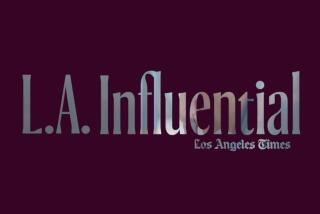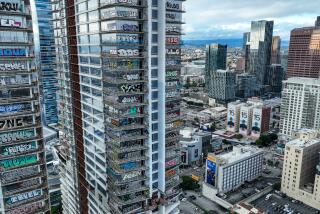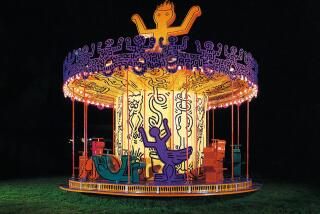Architect Charles Luckman Dies
Charles Luckman, entrepreneur, architect and civic and international leader who sold soap, designed skyscrapers, shuttled supplies to a hungry postwar Europe and funded campus programs, has died. He was 89.
Luckman died in his sleep early Tuesday at his Los Angeles home.
Luckman, who titled his 1988 autobiography “Twice in a Lifetime: From Soaps to Skyscrapers,” sold the soap back East but built his monuments in cities across the country, including Los Angeles, where he designed such landmarks as the Forum in Inglewood, the Federal Building in Westwood and the Los Angeles Convention Center.
Elsewhere, the architect created the Cape Canaveral Space Center in Florida, the Johnson Space Center in Houston, the new Madison Square Garden in New York, the Prudential Center in Boston, the Phoenix Civic Center, and Aloha Stadium in Honolulu--the first stadium with stands that move on a cushion of air to accommodate either football or baseball games.
With his uncanny knack of turning any situation into success, the Kansas City, Mo., youth dreamed of becoming an architect but easily veered into business when the Depression prompted a drop-off in building. He tucked away his 1931 architecture degree from the University of Illinois for 20 years, and got a job designing brochures to sell soap.
“It stinks,” his boss said in evaluating his first brochure, according to Luckman’s autobiography. Undaunted, Luckman replied, “If your salesmen can’t sell with that brochure, there’s something wrong with them” and then went out to sell the soap himself.
When he was 27, Time magazine called him the “boy wonder of American business.” By 33 he was president of Pepsodent Co. and by 37 he was president of Lever Bros.
About that time, President Harry Truman asked him to direct his Freedom Train project to help rebuild war-torn Europe. Luckman earned France’s Legion of Honor, England’s Order of St. John and Italy’s Star of Solidarity for his efforts.
An innovator in management as well as architecture, Luckman was an early champion of labor rights. In 1982, he became the first architect to receive the Henry Laurence Gantt Medal from the American Management Assn. for his “distinguished achievement of management as a service to the community.” He organized his own Luckman Partners in 1958 as the nation’s first major architectural firm to be entirely employee-owned.
Curiously, it was Luckman’s work as head of Lever Bros. that led him back to architecture. When he supervised the landmark Lever House headquarters in New York, he so enjoyed the project that he decided to design buildings. Critics called Lever House “Luckman’s Folly,” but the New York Landmark Commission noted years later that “Lever’s steel and glass building was among the first, as well as the most famous, corporate expressions of the Modern International style in America.”
Hooked on architecture, he left Lever Bros. in 1950 and joined William L. Pereira in an architectural firm. Eight years later, they formed separate companies.
Luckman’s designs occasionally drew criticism. One critic in The Times offered a stinging rebuke of Luckman’s Federal Building in Westwood: “What does it say about society that our government presents itself as a white box? . . . Luckman encased what is essentially a steel cage with a glass skin in a white corset.”
The architect, the critic added, may have been hampered by government requirements that he provide disparate agencies with a stated amount of square feet. Luckman might have called that giving the client what he needed. He prided himself on providing what clients wanted, not what architects think they should have.
“Learn to listen to your clients,” he told Cal Poly architectural students in 1982 in one of his frequent campus lectures. “It’s a shocking thought, but your client was smart enough to make enough money to hire you and to afford to build a building. Maybe, just maybe, he’s smart enough to know what his problems are. Listen. You just may possibly learn. Learn to listen; listen to learn.”
But Luckman’s designs went far beyond steel-and-glass boxes. When Los Angeles wanted a futuristic theme building to welcome the world to its new airport in 1962, Luckman headed a design team that came up with the arrangement of parabolic arches that continues to house an upscale restaurant and an observation deck.
In the early 1970s, Luckman designed what was then called the First Interstate Bank headquarters on 6th Street in downtown Los Angeles, then the city’s tallest building at 62 stories. In 1988, he listened on his car radio to reports of the building in flames, praying that nobody took the elevator, which could be fatal. One person did, and died.
Luckman’s other Los Angeles buildings include the Broadway (now Macy’s) Plaza, incorporating an office high-rise, a hotel and shopping and dining complexes on 7th Street downtown.
He also designed--and largely funded--the Charles and Harriet Luckman Building for the Los Angeles Child Guidance Clinic in South-Central Los Angeles and the Charles and Harriet Luckman Fine Arts Complex at Cal State L.A. in East Los Angeles.
“I felt there has been so much emphasis on the business and down-to-earth approach to life that it was time to take a deep breath collectively and remember what we established in this country was a culture,” Luckman said when he donated $2.1 million for the theater and art gallery complex.
Dedicated to education, Luckman served from 1960 to 1982 on the Cal State Board of Trustees and was twice elected chairman. He and his wife also funded the Harriet and Charles Luckman Distinguished Teaching Awards at UCLA.
Luckman served on the Educational Commission of the Fifty States and on boards of Adelphi, Northwestern, Pepperdine and Loyola universities and Caltech. He was also board chairman of the Brain Research Institute of UCLA and president of the Los Angeles Ballet, as well as board member of more than 60 civic and charitable organizations.
More than 50 years after Luckman’s graduation and 35 years after he started practicing architecture, the University of Illinois School of Architecture granted him its Illinois Medal in Architecture “in recognition of a lifetime of outstanding achievement and service to the profession of architecture.”
Survivors include his wife, Harriet, and three sons, Charles Jr., James and Stephen; eight grandchildren; and six great-grandchildren.
The family said services will be private and asked that any memorial donations be made to one of four organizations: the Los Angeles Child Guidance Clinic, 3787 S. Vermont Ave., Los Angeles 90007; the MUSES of the Museum of Science and Industry, Exposition Park, Los Angeles 90037; Los Angeles Founder Chapter, ARCS Foundation Inc., 1801 Avenue of the Stars, Gateway West Suite 708, Los Angeles 90067; or the Los Angeles Orphanage Guild, Maryvale, 7600 E. Graves Ave., Rosemead, CA 91770.
More to Read
The biggest entertainment stories
Get our big stories about Hollywood, film, television, music, arts, culture and more right in your inbox as soon as they publish.
You may occasionally receive promotional content from the Los Angeles Times.










